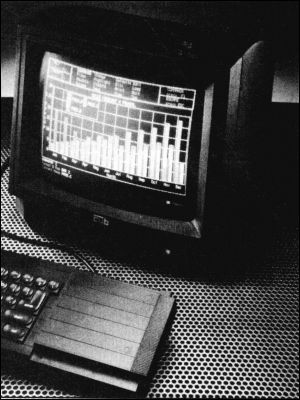| Business |
| Which means business, Spectrum or QL? |
EVER SINCE its launch the Spectrum has never been considered as a business computer. Yet it is still being used by a considerable number of companies, including some very large ones.

QL at work - can the Spectrum compete? |
It was hoped that the QL would be taken much more seriously. Various factors, including all the old familiar problems with delays and reliability, consigned it initially to a limbo acknowledged as a powerful machine using tomorrow's technology, resisted for serious use. When many of the problems were finally sorted out the QL was already being caught up and surpassed by the market.
A reduction in price, together with the improved quality, has changed the picture and many companies are reconsidering it as a possibility for their needs. With the QL moving into the Spectrum market, does the Spectrum still have a role to play in business, or should it now be seen purely as an entry level games machine?
For many people a business computer should have one disc drive - preferably two, at least 64K of memory, output to a monitor and a range of other output ports. In addition, it should use either the CP/M or MSDOS operating systems.
Neither the Spectrum or QL have all those features. The Spectrum has 48K of memory, output to TV, tape storage and no other output ports, while the QL includes 128K, two microdrives for fast storage and output to TV or monitor. A suite of very good programs word processing, spreadsheet, database and business graphics is bundled with the QL. That suite alone is worth the £199 price.
Should you want to speed up saving and loading by adding microdrives to your Spectrum, it is going to cost a further £120 for the interface and two microdrives. Of course, disc drives are available for both the Spectrum and QL but adding one will cost about £200. On the face of it, it would seem impossible for there to be any life left in the Spectrum for business use.
However, all that assumes that your computer will be used for a range of programs throughout the working day. It makes no assumptions about dedicating a-computer to a single task. Word processors are dedicated computers and there are perhaps more of those than any other type of computer. The use of dedicated computers is likely to be one of the few growth areas for computers.
There are several factors which make the Spectrum suitable in this area. A major factor is obviously going to be the cost of the whole system and, while it may be more expensive to buy a Spectrum with twin microdrives than a QL, the Spectrum Plus is still £70 cheaper: If you can find an old rubber keyboard model the saving could be £140.
The cost of software is another factor. The best programs retain many of the features of programs written especially for business computers while being about one tenth of the cost. Using a television to display results means that a further £30 or £40 can be saved.
The Spectrum is a small, robust machine which has a little footprint - it takes up little desk space. It can stay switched on all day and stands up to considerable wear and tear. Saving and loading from cassette tape is, admittedly, slow and tedious. However cassette tape is probably the safest medium for storing data.
All those features combine to make the Spectrum highly suitable as the basis of a cheap dedicated system - such as for stock control, where it needs to be turned on first thing in the morning and will be left running all day.
The Spectrum will continue to be used where it has already made its mark and a reduction in price could renew interest at the time of writing Asda is selling the Spectrum Plus for £70. It may also be that as a generation of young gameplayers grow up either they, or their parents, will start using their old forgotten Spectrums in business. Undoubtedly, the Spectrum is not dead where the business market is concerned.
Mike Wright
|